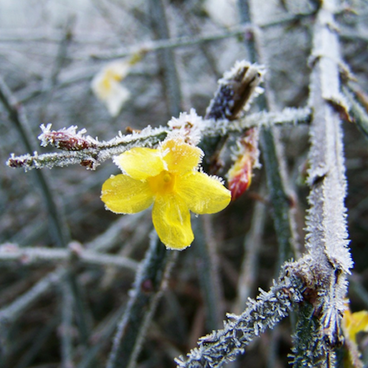Warmer Winters Have Diverse Effects on Tree Growth
Write up by Soham Mistry on Claudia Nanninga's research.
First Published by the NSF's Long-Term Ecological Research Network.
A group of scientists at the University of Minnesota found that five temperate deciduous tree species common throughout North America actually begin budding later in the year with decreased exposure to chilling. The researchers conducted a controlled experiment spanning two years, in which they exposed the five species to varying temperatures to simulate winters of different lengths and intensities. Read More...
Under construction:
Current Research Projects
Climate change experiments
Will future weather favor Minnesota’s woody invaders? Reich, P. (PI) RA Montgomery (co-I). Minnesota Terrestrial Invasive Plants and Pests Center.
Warming-induced biome change at the temperate-boreal ecotone: An experimental test of key regeneration processes (PI Peter Reich (with Rebecca Montgomery, Artur Stefanski, Raimundo Bermudez, Sarah Hobbie)
Phenology
Indicators of Menominee forest responses to climate change. PI: Chris Caldwell. Co-PI R.A. Montgomery. USDA-NIFA Tribal Colleges Research Grants Program.
Improve invasive plant treatment efficacy using climate based phenology models. Lead PI: Rebecca Montgomery. Minnesota Terrestrial Invasive Plants and Pests Center.
Applied research
Prescribed burning for brushland dependent species - Phase II. Lead PI: Rebecca Montgomery. LCCMR
Promoting and Restoring Oak Savanna using Silvopasture. PI: Rebecca Montgomery. LCCMR.
Accurate detection of oak wilt disease from tree to landscape scales for enhanced forest management. Co-PIs J. Cavender-Bares, J. Juzwik and R.A. Montgomery. Minnesota Terrestrial Invasive Plants and Pests Center.
ArtScience & Community Engagement
Engaging Minnesotans with Phenology: Radio, Podcasts, Citizen Science. Lead PI: Maggie Montgomery, KAXE. LCCMR.
Backyard Phenology: Integrating citizen science and public art to build collective agency on climate change w/ Christine Baeumler and Beth Mercer-Taylor. Current community collaboration with Metro Blooms
LTER Network
I am involved in the following LTER sites:
Current Undergraduate Projects
Past projects
Developing integrated management techniques for controlling invasive reed canary grass and regenerating floodplain forests (co-PIs, Rebecca Montgomery, and Meredith Thomsen, University of Wisconsin-La Crosse; NRSM Graduate RA, Maria DeLaundreau; University of Wisconsin-La Crosse Graduate RA, Bill Kiser) Funded by LCCMR
Invasive reed canary grass (Phalaris arundinacea) threatens regeneration of native bottomland forest tree species along the Mississippi River and its tributaries. This project will explore different ways to control reed canary grass, including mechanical and chemical control, and using various planting types of cottonwood (Populus deltoides), silver maple (Acer saccharinum), swamp white oak (Quercus bicolor), and hackberry (Celtis occidentalis) to determine effective management techniques for artificially regenerating bottomland forests once reed canary grass has been controlled. Regeneration, though limited, is occurring in some locations. Where regeneration is found, site location and conditions (hydrology, soils, sunlight, plant competition) will be recorded to help determine why regeneration is successful. The results will aid foresters and wildlife managers in implementing the most efficient methods to restore and sustain critical floodplain forest habitats. Funded by LCCMR and Audubon Minnesota.
Managing for complex structure and wood productivity in red pine ecosystems (PI Brian Palik, North Central Research Station, USDA Forest Service; co-PIs, Rebecca Montgomery, Peter Reich, U of MN, Dept. of Forest Resources)
In managed forests, emulation of natural disturbances has gained acceptance as an approach for sustaining species diversity and ecological complexity. Overstory retention, where large trees are retained during harvest, is a popular tool to emulate the structural outcomes of natural disturbance. The major objective of this project is to understand how characteristics of retention systems can be manipulated to sustain both wood productivity and ecological complexity. Implementation of results from this study will support efforts to increase biodiversity in production forests. Our project evaluates management systems designed to 1) sustain economic opportunities, through wood production, while enhancing the quality of life in rural America, and 2) protect and enhance the Nation’s natural resource base by sustaining ecologically sound managed forests. Past funding by USDA Forest Service NRI and past funding from the Wilderness Research Foundation
